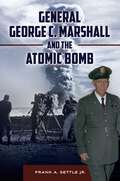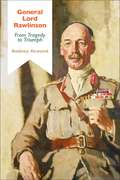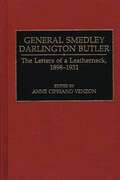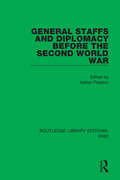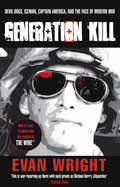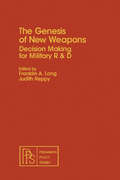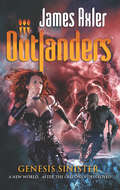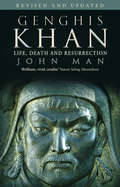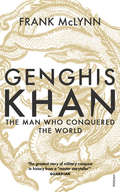- Table View
- List View
General Dynamics F-111F- Jet Combat Aircraft (UEB Contracted)
by Rnib BookshareDeep-strike Interdictor This is an image of a jet combat aircraft seen from above. There is a locator dot shown, which will be at the top left of the page when the image is the correct way up. The image is in the centre and a scale in metres on the left of the page. The aircraft nose is in the top centre and the tail in the bottom centre of the page. The fuselage goes up and down the middle of the page. The cockpit cover is shown as four windows near the nose. The wings go sharply down to the left and right in a swept position. The dotted lines to left and right show the position of the wings when in unswept position. The wings each have three ailerons on the rear edge of the wing. At the bottom of the page in the centre of the fuselage is the vertical tail. To each side of this is the tailplane. The jet output nozzles are to the left and right of the vertical tail. The plane is grey although it was commonly painted with camouflage colours. The textures on the tactile image reflect structure not colour. There is a different texture for the cockpit, wings, engine and fuselage. The F-111F is a variable geometry aircraft whose wings extend at low speed and fold in at high speed to reduce drag.
General Dynamics F-111F- Jet Combat Aircraft (UEB contracted)
by RnibThis is an image of a jet combat aircraft seen from above. There is a locator dot shown, which will be at the top left of the page when the image is the correct way up. The image is in the centre and a scale in metres on the left of the page. The aircraft nose is in the top centre and the tail in the bottom centre of the page. The fuselage goes up and down the middle of the page. The cockpit cover is shown as four windows near the nose. The wings go sharply down to the left and right in a swept position. The dotted lines to left and right show the position of the wings when in unswept position. The wings each have three ailerons on the rear edge of the wing. At the bottom of the page in the centre of the fuselage is the vertical tail. To each side of this is the tailplane. The jet output nozzles are to the left and right of the vertical tail. The plane is grey although it was commonly painted with camouflage colours. The textures on the tactile image reflect structure not colour. There is a different texture for the cockpit, wings, engine and fuselage. The F-111F is a variable geometry aircraft whose wings extend at low speed and fold in at high speed to reduce drag.
General Dynamics F-111F- Jet Combat Aircraft (UEB Uncontracted)
by Rnib BookshareDeep-strike Interdictor This is an image of a jet combat aircraft seen from above. There is a locator dot shown, which will be at the top left of the page when the image is the correct way up. The image is in the centre and a scale in metres on the left of the page. The aircraft nose is in the top centre and the tail in the bottom centre of the page. The fuselage goes up and down the middle of the page. The cockpit cover is shown as four windows near the nose. The wings go sharply down to the left and right in a swept position. The dotted lines to left and right show the position of the wings when in unswept position. The wings each have three ailerons on the rear edge of the wing. At the bottom of the page in the centre of the fuselage is the vertical tail. To each side of this is the tailplane. The jet output nozzles are to the left and right of the vertical tail. The plane is grey although it was commonly painted with camouflage colours. The textures on the tactile image reflect structure not colour. There is a different texture for the cockpit, wings, engine and fuselage. The F-111F is a variable geometry aircraft whose wings extend at low speed and fold in at high speed to reduce drag.
General Dynamics F-111F- Jet Combat Aircraft (UEB uncontracted)
by RnibThis is an image of a jet combat aircraft seen from above. There is a locator dot shown, which will be at the top left of the page when the image is the correct way up. The image is in the centre and a scale in metres on the left of the page. The aircraft nose is in the top centre and the tail in the bottom centre of the page. The fuselage goes up and down the middle of the page. The cockpit cover is shown as four windows near the nose. The wings go sharply down to the left and right in a swept position. The dotted lines to left and right show the position of the wings when in unswept position. The wings each have three ailerons on the rear edge of the wing. At the bottom of the page in the centre of the fuselage is the vertical tail. To each side of this is the tailplane. The jet output nozzles are to the left and right of the vertical tail. The plane is grey although it was commonly painted with camouflage colours. The textures on the tactile image reflect structure not colour. There is a different texture for the cockpit, wings, engine and fuselage. The F-111F is a variable geometry aircraft whose wings extend at low speed and fold in at high speed to reduce drag.
General George C. Marshall and the Atomic Bomb
by Frank A. Jr.This book details the evolution of General George Marshall's relationship with the atomic bomb—including the Manhattan Project and the use of atomic weapons on Japan—as it emerged as the ultimate weapon of mass destruction.The atomic bomb is not only the most powerful weapon ever used in the history of warfare: it is also the most significant in terms of its long-term impact on U.S. military power and policy, and as the reason behind the conflict that raged for four decades without actually happening—the Cold War. General George C. Marshall played an instrumental role in the development and use of the atomic bomb in World War II as well as in issues involving nuclear weapons in the post-World War II period. This book tells the story of Marshall's experience with the atomic bomb from his early skepticism of its effectiveness as a weapon, to his oversight of its development and deployment against Japan in World War II, to his recognition of the bomb as a weapon of such dire consequence that it should never be used again.Intended for a general audience as well as scholars with specific knowledge about the subject matter, this book presents a cohesive account of General Marshall's involvement with nuclear weapons and atomic power as Army chief of staff during World War II and as secretary of state and secretary of defense in the early years of the Cold War. Marshall's involvement with the use of nuclear weapons is set in the context of the Allies' efforts to force Japan to surrender and the initiation of the Cold War. Readers will gain insight into Marshall's quest for obtaining a Japanese surrender; his views on the use of the atomic bomb on Japan versus the use of conventional weapons, including fire bombing or poison gas; his interactions with Roosevelt and Truman on nuclear issues; and Marshall's diplomatic skillfulness in dealing with the issues surrounding the control and use of nuclear weapons as secretary of state and secretary of defense in the post-World War II era. These included consideration of the use of the atomic bomb during the Berlin crisis and the Korean war.
General George C. Marshall and the Atomic Bomb
by Frank A. Jr.This book details the evolution of General George Marshall's relationship with the atomic bomb—including the Manhattan Project and the use of atomic weapons on Japan—as it emerged as the ultimate weapon of mass destruction.The atomic bomb is not only the most powerful weapon ever used in the history of warfare: it is also the most significant in terms of its long-term impact on U.S. military power and policy, and as the reason behind the conflict that raged for four decades without actually happening—the Cold War. General George C. Marshall played an instrumental role in the development and use of the atomic bomb in World War II as well as in issues involving nuclear weapons in the post-World War II period. This book tells the story of Marshall's experience with the atomic bomb from his early skepticism of its effectiveness as a weapon, to his oversight of its development and deployment against Japan in World War II, to his recognition of the bomb as a weapon of such dire consequence that it should never be used again.Intended for a general audience as well as scholars with specific knowledge about the subject matter, this book presents a cohesive account of General Marshall's involvement with nuclear weapons and atomic power as Army chief of staff during World War II and as secretary of state and secretary of defense in the early years of the Cold War. Marshall's involvement with the use of nuclear weapons is set in the context of the Allies' efforts to force Japan to surrender and the initiation of the Cold War. Readers will gain insight into Marshall's quest for obtaining a Japanese surrender; his views on the use of the atomic bomb on Japan versus the use of conventional weapons, including fire bombing or poison gas; his interactions with Roosevelt and Truman on nuclear issues; and Marshall's diplomatic skillfulness in dealing with the issues surrounding the control and use of nuclear weapons as secretary of state and secretary of defense in the post-World War II era. These included consideration of the use of the atomic bomb during the Berlin crisis and the Korean war.
General Jan Smuts And his First World War in Africa (1914-19-17)
by David Brock Katz‘An engaging, well-written and meticulously researched military biography …’ – Tim Stapleton, Professor, Department of History, University of CalgaryJan Smuts grabbed the opportunity to realise his ambition of a Greater South Africa when the First World War ushered in a final scramble for Africa. He set his sights firmly northward upon the German colonies of South West Africa and East Africa.Smuts’s abilities as a general have been much denigrated by his contemporaries and later historians, but he was no armchair soldier. He first learned his soldier’s craft under General Koos de la Rey and General Louis Botha during the South African War (1899−1902). He emerged from that conflict immersed in Boer manoeuvre doctrine.After forming the Union Defence Force in 1912, Smuts played an integral part in the German South West African campaign in 1915. Placed in command of the Allied forces in East Africa in 1916, he led a mixed bag of South Africans and imperial troops against the legendary Paul von Lettow-Vorbeck and his Schutztruppen. His penchant for manoeuvre warfare and mounted infantry freed most of the vast German territory from Lettow-Vorbeck’s grip.General Jan Smuts and his First World War in Africa provides a long-overdue reassessment of Smuts’s generalship and his role in furthering the strategic aims of South Africa and the British Empire during this era.
General Lord Rawlinson: From Tragedy to Triumph (Bloomsbury Studies in Military History)
by Rodney AtwoodIn this biography Rodney Atwood details the life of General Lord Rawlinson of Trent (1864-1925), a distinguished British soldier whose career culminated in decisive victories on the Western Front in 1918 and command of the Indian Army in the early 1920s. He served his soldier's apprenticeship in the Victorian colonial wars in Burma, the Sudan and South Africa. His career provides a lens through which to examine the British Army in the late-19th and early-20th century. In the South African War (1899-1902) Rawlinson's ideas aided the defence of Ladysmith, and he distinguished himself leading a mobile column in the guerrilla war. In the First World War he held an important command in most of the British Expeditionary Force's battles on the Western Front. He bears a heavy part-responsibility for the disastrous first day of the Somme, but later in the battle his successful tactics inflicted heavy losses on the enemy. His Western Front career culminated in a series of victories beginning at Amiens. He commanded the Indian Army between 1920 and 1925 at a time of military and political tension following the 3rd Afghan War and the Amritsar Massacre. He introduced necessary reforms, cut expenditure at a time of postwar retrenchment and began commissioning Indians to replace British officers. He would have taken up the post of CIGS (Chief of the Imperial General Staff), thus being the only British soldier to hold these two top posts. He died, however, four days after his sixty-first birthday. Drawing extensively on archival material including Rawlinson's own engagingly-written letters and diaries, this thorough examination of his life will be of great interest to those studying British military history, imperial history and the First World War.
General Lord Rawlinson: From Tragedy to Triumph (Bloomsbury Studies in Military History)
by Rodney AtwoodIn this biography Rodney Atwood details the life of General Lord Rawlinson of Trent (1864-1925), a distinguished British soldier whose career culminated in decisive victories on the Western Front in 1918 and command of the Indian Army in the early 1920s. He served his soldier's apprenticeship in the Victorian colonial wars in Burma, the Sudan and South Africa. His career provides a lens through which to examine the British Army in the late-19th and early-20th century. In the South African War (1899-1902) Rawlinson's ideas aided the defence of Ladysmith, and he distinguished himself leading a mobile column in the guerrilla war. In the First World War he held an important command in most of the British Expeditionary Force's battles on the Western Front. He bears a heavy part-responsibility for the disastrous first day of the Somme, but later in the battle his successful tactics inflicted heavy losses on the enemy. His Western Front career culminated in a series of victories beginning at Amiens. He commanded the Indian Army between 1920 and 1925 at a time of military and political tension following the 3rd Afghan War and the Amritsar Massacre. He introduced necessary reforms, cut expenditure at a time of postwar retrenchment and began commissioning Indians to replace British officers. He would have taken up the post of CIGS (Chief of the Imperial General Staff), thus being the only British soldier to hold these two top posts. He died, however, four days after his sixty-first birthday. Drawing extensively on archival material including Rawlinson's own engagingly-written letters and diaries, this thorough examination of his life will be of great interest to those studying British military history, imperial history and the First World War.
General Percy Kirke and the Later Stuart Army
by John ChildsGeneral Percy Kirke (c. 1647-91) is remembered in Somerset as a cruel, vicious thug who deluged the region in blood after the Battle of Sedgemoor in 1685. He is equally notorious in Northern Ireland. Appointed to command the expedition to raise the Siege of Londonderry in 1689, his assumed treachery nearly resulted in the city's fall and he was made to look ridiculous when the blockade was eventually lifted by a few sailors in a rowing boat. Yet Kirke was closely involved in some of the most important events in British and Irish history. He served as the last governor of the colony of Tangier; played a central role in facilitating the Glorious Revolution of 1688; and fought in the majority of the principal actions and campaigns undertaken by the newly-formed standing armies in England, Ireland and Scotland, especially the Battle of the Boyne and the first Siege of Limerick in 1689. With the aid of his own earlier work in the field, additional primary sources and a recently-rediscovered letter book, John Childs looks beyond the fictionalisation of Kirke, most notably by R. D. Blackmore in Lorna Doone, to investigate the historical reality of his career, character, professional competence, politics and religion. As well as offering fresh, detailed narratives of such episodes as Monmouth's Rebellion, the conspiracies in 1688 and the Siege of Londonderry, this pioneering biography also presents insights into contemporary military personnel, patronage, cliques and procedures.
General Percy Kirke and the Later Stuart Army
by John ChildsGeneral Percy Kirke (c. 1647-91) is remembered in Somerset as a cruel, vicious thug who deluged the region in blood after the Battle of Sedgemoor in 1685. He is equally notorious in Northern Ireland. Appointed to command the expedition to raise the Siege of Londonderry in 1689, his assumed treachery nearly resulted in the city's fall and he was made to look ridiculous when the blockade was eventually lifted by a few sailors in a rowing boat. Yet Kirke was closely involved in some of the most important events in British and Irish history. He served as the last governor of the colony of Tangier; played a central role in facilitating the Glorious Revolution of 1688; and fought in the majority of the principal actions and campaigns undertaken by the newly-formed standing armies in England, Ireland and Scotland, especially the Battle of the Boyne and the first Siege of Limerick in 1689. With the aid of his own earlier work in the field, additional primary sources and a recently-rediscovered letter book, John Childs looks beyond the fictionalisation of Kirke, most notably by R. D. Blackmore in Lorna Doone, to investigate the historical reality of his career, character, professional competence, politics and religion. As well as offering fresh, detailed narratives of such episodes as Monmouth's Rebellion, the conspiracies in 1688 and the Siege of Londonderry, this pioneering biography also presents insights into contemporary military personnel, patronage, cliques and procedures.
General Smedley Darlington Butler: The Letters of a Leatherneck, 1898-1931
by Ann Cipriano VenzonMajor General Smedley Darlington Butler was a maverick Marine, the emblem of the old corps, and one of the most controversial figures in Marine history. He was a high school dropout who became a major general; a Quaker and a devout family man who was one of the toughest of the Marines; an aristocrat who championed the common man; a leader who thought of himself as striving to help the oppressed of the countries he occupied as the commander of an imperial fighting force. This work is an annotated edition of his letters covering the period from Butler's commissioning as a Second Lieutenant in the U.S. Marine Corps to his retirement as a Major General.This is the first time the majority of these letters have been made public, and the book offers the reader a first-hand look at the motivations and attitudes of the American military as it implemented U.S. foreign policy at the turn of the century. There is extensive coverage of U.S. interventions in Nicaragua, Haiti, and China from a man on the scene, offering an immediate perspective to those events. General Butler won two Congressional Medals of Honor, as well as numerous other U.S. and foreign medals, including two Umbrellas of Ten Thousand Blessings from two Chinese cities--honors never before given to a non-Chinese. Military and diplomatic historians, as well as Marine and Navy enthusiasts, will find this superbly edited and annotated collection of interest and value.
General Staffs and Diplomacy before the Second World War (Routledge Library Editions: WW2 #10)
by Adrian PrestonThis book, first published in 1978, examines the influence of the General Staffs upon the diplomacy of appeasement and rearmament between 1931 and 1941. The great question of European security and order, and their breakdown and the outbreak of the second world war, are examined here through the eyes of Cabinets and Foreign Offices as well as through the eyes of Chiefs of Staff.
General Staffs and Diplomacy before the Second World War (Routledge Library Editions: WW2 #10)
by Adrian PrestonThis book, first published in 1978, examines the influence of the General Staffs upon the diplomacy of appeasement and rearmament between 1931 and 1941. The great question of European security and order, and their breakdown and the outbreak of the second world war, are examined here through the eyes of Cabinets and Foreign Offices as well as through the eyes of Chiefs of Staff.
The Generals' Civil War: What Their Memoirs Can Teach Us Today (Civil War America)
by Stephen CushmanIn December 1885, under the watchful eye of Mark Twain, the publishing firm of Charles L. Webster and Company released the first volume of the Personal Memoirs of Ulysses S. Grant. With a second volume published in March 1886, Grant's memoirs became a popular sensation. Seeking to capitalize on Grant's success and interest in earlier reminiscences by Joseph E. Johnston, William T. Sherman, and Richard Taylor, other Civil War generals such as George B. McClellan and Philip H. Sheridan soon followed suit. Some hewed more closely to Grant's model than others, and their points of similarity and divergence left readers increasingly fascinated with the history and meaning of the nation's great conflict. The writings also dovetailed with a rising desire to see the full sweep of American history chronicled, as its citizens looked to the start of a new century. Professional historians engaged with the memoirs as an important foundation for this work. In this insightful book, Stephen Cushman considers Civil War generals' memoirs as both historical and literary works, revealing how they remain vital to understanding the interaction of memory, imagination, and the writing of American history. Cushman shows how market forces shaped the production of the memoirs and, therefore, memories of the war itself; how audiences have engaged with the works to create ideas of history that fit with time and circumstance; and what these texts tell us about current conflicts over the history and meanings of the Civil War.
The Generals Of Gettysburg: the Leaders Of America's Greatest Battle
by Larry TaggFilled with insightful anecdotes and lively narrative, The Generals of Gettysburg presents detailed information on the character and personality of all 133 combat-command officers as well as an in-depth account of each man's actions on the field. This marriage of character --the features and attributes of a man--with each general's battlefield record, offers new insights into the battle and its outcome.
The Generals Of Gettysburg: the Leaders Of America's Greatest Battle
by Larry TaggFilled with insightful anecdotes and lively narrative, The Generals of Gettysburg presents detailed information on the character and personality of all 133 combat-command officers as well as an in-depth account of each man's actions on the field. This marriage of character --the features and attributes of a man -- with each general's battlefield record, offers new insights into the battle and its outcome.
Generation Exodus: The Fate of Young Jewish Refugees from Nazi Germany
by Walter LaqueurA unique generational history of the young people whose lives were irrevocably shaped by the rise of the Nazis. Half a million Jews lived in Germany when Hitler came to power in 1933. Over the next decade, thousands would flee. Among these refugees, teens and young adults formed a remarkable generation. They were old enough to appreciate the loss of their homeland and the experience of flight, but often young and flexible enough to survive and even flourish in new environments. This generation has produced such disparate figures as Henry Kissinger and 'Dr. Ruth' Westheimer. Laqueur has drawn on interviews, published and unpublished memoirs and his own experiences as a member of this group of refugees to paint a vivid and moving portrait of Generation Exodus.'Laqueur has undertaken the daunting task of writing the collective biography of a generation unique in history…I can testify that Laqueur has succeeded admirably.' Dr. Henry A. Kissinger
Generation Kill: Devil Dogs, Iceman, Captain America, And The New Face Of American War (Playaway Adult Nonfiction Ser.)
by Evan WrightGeneration Kill is about the young men sent to fight their nation's first open-ended war since Vietnam. Despite the flurry of media images to come of the recent wars in Afghanistan and Iraq, you have never really met any of these people, who serve as front-line troops. For whatever reason, the media simply doesn't get them. As we all know, news accounts of the last two wars focused almost exclusively on battlefield imagery of high-tech weapons wreaking astounding destruction, comply with analysis from retired army grandees and other experts, punctuated by the odd heart-warming patriotic sound-bite. The troops themselves play a role in the media's presentation of recent wars rather like extras in The Triumph of the Will. They are everywhere yet somehow invisible. When they speak you get the sense that what they are saying has been carefully scripted. Now Generation Kill tells the soldiers' story in their own words.The narrative focuses on a platoon of 23 marines, many of them veterans of Afghanistan, whose elite reconnaissance unit spearheaded the blitzkrieg on Iraq. This is the story of young men that have been trained to become ruthless killers. It's about surviving death. It's about taking part in a war many questioned before it even began.Evan Wright was the only reporter with First Recon, which operated well ahead of most other forces, usually behind enemy lines. They were among the first marines sent into the fight and one of the last units still engaged on the outskirts of Iraq, even after the city centre fell. Generation Kill is not just a combat chronicle but an inside look at how people fighting in war actually experience it. It is both an action narrative like Black Hawk Down and a detailed portrait of a generation at war along the lines of Band of Brothers. It is not a book you are going to forget in a hurry...
The Genesis of New Weapons: Decision Making for Military R & D
by Franklin A. Long Judith ReppyThe Genesis of New Weapons: Decision Making for Military R&D covers the meeting held to convene military officers, civilian managers of R&D programs, and members of the research groups in industry and get insights from them regarding the decision-making process for initiation and carrying out of R&D programs. The book first gives an introductory overview of the decision making in the military R&D. Topics on the problems usually encountered are then examined. These problems include bureaucratic and other problems in planning and managing military, decision making, and defense. Then, the text discusses the birth of weapons and the R&D process. Finally, the book looks into the political intervention and its implications for the military R&D. The selection will be beneficial to those in the military, government offices, and related agencies or sectors.
Genesis Sinister
by James AxlerThe epic battle between two would-be gods to rule earth may have ended, but the struggle to survive aliens of near-immortal powers–aliens determined to cage humankind–continues. As the freedom fighters of the Cerberus organization regroup and press on, a shattering storm heads toward the planet…the blood tide of a new apocalypse.
Genghis Khan: Life, Death, And Resurrection
by John ManGenghis Khan - creator of the greatest empire the world has ever seen - is one of history's immortals. In Central Asia, they still use his name to frighten children. In China, he is honoured as the founder of a dynasty. In Mongolia he is the father of the nation. In the USA, Time magazine, voted Genghis Khan 'the most important person of the last millennium'. But how much do we really know about this man? How is it that an unlettered, unsophisticated warrior-nomad came to have such a profound effect on world politics that his influence can still be felt some 800 years later? How he united the deeply divided Mongol peoples and went on to rule an empire that stretched from China in the east to Poland in the west (one substantially larger than Rome's at its zenith) is an epic tale of martial genius and breathtaking cruelty. John Man's towering achievement in this book, enriched by his experiences in China and Mongolia today, is to bring this little-known story vividly and viscerally to life.
Genghis Khan: The Man Who Conquered the World
by Frank McLynnGenghis Khan was by far the greatest conqueror the world has ever known, whose empire stretched from the Pacific Ocean to central Europe, including all of China, the Middle East and Russia. So how did an illiterate nomad rise to such colossal power, eclipsing Alexander the Great, Julius Caesar and Napoleon? Credited by some with paving the way for the Renaissance, condemned by others for being the most heinous murderer in history, who was Genghis Khan? His actual name was Temujin, and the story of his success is that of the Mongol people: a loose collection of fractious tribes who tended livestock, considered bathing taboo and possessed an unparallelled genius for horseback warfare. United under Genghis, a strategist of astonishing cunning and versatility, they could dominate any sedentary society they chose.Combining fast-paced accounts of battles with rich cultural background and the latest scholarship, Frank McLynn brings vividly to life the strange world of the Mongols, describes Temujin’s rise from boyhood outcast to become Genghis Khan, and provides the most accurate and absorbing account yet of one of the most powerful men ever to have lived.
Genghis Khan & the Mongol Conquests 1190–1400 (Guide to...)
by Dr Stephen TurnbullThe history of the Mongol conquests is a catalogue of superlatives. No army in the world has ever conquered so much territory, and few armies have provoked such terror as the Mongol hordes. So vast was the extent of the Mongol Empire that the samurai of Japan and the Teutonic Knights of Prussia had each fought the same enemy while being unaware of each other's existence. This book provides a concise yet thorough account of the Mongol conquests, including the rise of Genghis Khan and the unification of the tribes with up to date information on campaign logistics, tactics and horse breeding.
Genocide and the Global Village
by K. CampbellA half-century ago, the international community made a solemn promise to 'never again' allow genocide to go unchallenged. In the early days of the Post-Cold War 'New World Order,' though, international leaders failed to stop horrific genocides in Bosnia and Rwanda, chiefly because Western leaders lack the 'political will' to use decisive force to suppress ongoing genocide. Despite increased attention to war crimes issues in the Clinton Administration, and increased rhetoric about its commitment to halting genocide, American military force policy still gives lowest priority to responding to gross abuses of human rights. In Genocide and the Global Village , Kenneth Campbell explains why the international community fails so miserably to prevent, suppress, and punish contemporary genocide. The book integrates the scattered pieces of this complex problem - political, military, legal, and ethical - into a more complete, clearer picture of the challenge facing the world today. Campbell engages in a complex, multi-level analysis of genocide's impact upon world order, and the inter-play of politics and morality in the international community's determination of the appropriate role for military force in halting genocide and securing an emerging global civil society. Campbell recommends practical steps the international community can take to greatly improve its response the next time genocide occurs - a next time that will occur.

